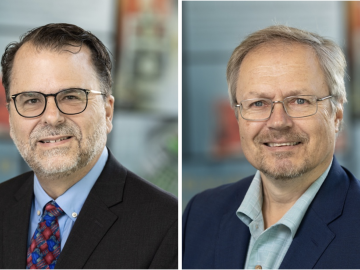
Filter News
Area of Research
- Advanced Manufacturing (22)
- Biological Systems (1)
- Biology and Environment (44)
- Building Technologies (4)
- Clean Energy (198)
- Computational Biology (2)
- Computational Engineering (1)
- Computer Science (4)
- Electricity and Smart Grid (3)
- Energy Sciences (1)
- Functional Materials for Energy (2)
- Fusion and Fission (13)
- Fusion Energy (7)
- Isotope Development and Production (1)
- Isotopes (29)
- Materials (98)
- Materials for Computing (9)
- National Security (14)
- Neutron Science (36)
- Nuclear Science and Technology (23)
- Nuclear Systems Modeling, Simulation and Validation (1)
- Quantum information Science (1)
- Sensors and Controls (1)
- Supercomputing (46)
News Topics
- (-) 3-D Printing/Advanced Manufacturing (128)
- (-) Advanced Reactors (35)
- (-) Biomedical (61)
- (-) Biotechnology (24)
- (-) Buildings (67)
- (-) Energy Storage (112)
- (-) Grid (67)
- (-) Isotopes (57)
- (-) Physics (64)
- (-) Space Exploration (25)
- (-) Transformational Challenge Reactor (7)
- Artificial Intelligence (102)
- Big Data (62)
- Bioenergy (92)
- Biology (101)
- Chemical Sciences (73)
- Clean Water (31)
- Climate Change (106)
- Composites (30)
- Computer Science (199)
- Coronavirus (46)
- Critical Materials (29)
- Cybersecurity (35)
- Decarbonization (85)
- Education (5)
- Element Discovery (1)
- Emergency (2)
- Environment (201)
- Exascale Computing (44)
- Fossil Energy (6)
- Frontier (46)
- Fusion (59)
- High-Performance Computing (94)
- Hydropower (11)
- Irradiation (3)
- ITER (7)
- Machine Learning (51)
- Materials (149)
- Materials Science (149)
- Mathematics (10)
- Mercury (12)
- Microelectronics (4)
- Microscopy (51)
- Molten Salt (9)
- Nanotechnology (60)
- National Security (73)
- Net Zero (14)
- Neutron Science (139)
- Nuclear Energy (111)
- Partnerships (51)
- Polymers (33)
- Quantum Computing (38)
- Quantum Science (72)
- Renewable Energy (2)
- Security (26)
- Simulation (53)
- Software (1)
- Statistics (3)
- Summit (61)
- Sustainable Energy (130)
- Transportation (99)
Media Contacts

A study led by the Department of Energy’s Oak Ridge National Laboratory details how artificial intelligence researchers created an AI model to help identify new alloys used as shielding for housing fusion applications components in a nuclear reactor. The findings mark a major step towards improving nuclear fusion facilities.

A new technical collaboration program at the Department of Energy’s Oak Ridge National Laboratory will help businesses develop and launch electric grid innovations. Sponsored by the Transformer Resilience and Advanced Components program in DOE’s Office of Electricity, the initiative will provide companies with access to national laboratory resources, enabling them to capture market opportunities.

Stephen Kowalski and Mikael Salonvaara received the Distinguished Service Award, which salutes members who have served the society with distinction in chapter, regional and society activities.

Kashif Nawaz, distinguished researcher and section head for Building Technologies Research at the Department of Energy’s Oak Ridge National Laboratory, has been named a Fellow of the American Society of Mechanical Engineers, or ASME.

Katy Bradford is on a mission to revolutionize the construction industry and is the founder of Cassette Construction, a company in the newest cohort of Innovation Crossroads, a DOE Lab-Embedded Entrepreneurship Program node at ORNL. As an Innovation Crossroads fellow, Bradford and her company will receive technical, financial and networking support to successfully advance the company’s products to the marketplace.
After retiring from Y-12, Scott Abston joined the Isotope Science and Engineering Directorate to support isotope production and work with his former manager. He now leads a team maintaining critical equipment for medical and space applications. Abston finds fulfillment in mentoring his team and is pleased with his decision to continue working.

A new convergent manufacturing platform, developed in only five months at the Department of Energy’s Oak Ridge National Laboratory, is debuting at the International Manufacturing Technology Show, or IMTS, in Chicago, Sept. 9–12, 2024.

A team led by scientists at ORNL identified and demonstrated a method to process a plant-based material called nanocellulose that reduced energy needs by a whopping 21%, using simulations on the lab’s supercomputers and follow-on analysis.

ORNL is working with industry partners to develop a technique that combines 3D printing and conventional machining to produce large metal parts for clean energy applications. The project, known as Rapid Research on Universal Near Net Shape Fabrication Strategies for Expedited Runner Systems, or Rapid RUNNERS, recently received $15 million in funding from DOE.

As a mechanical engineer in building envelope materials research at ORNL, Bryan Maldonado sees opportunities to apply his scientific expertise virtually everywhere he goes, from coast to coast. As an expert in understanding how complex systems operate, he’s using machine learning methods to control the process and ultimately optimize performance.


